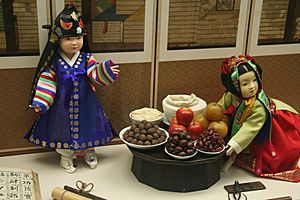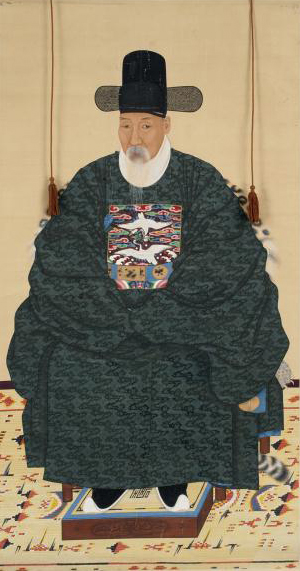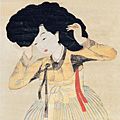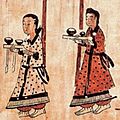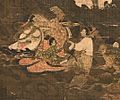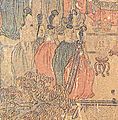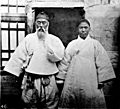Hanbok facts for kids
Hanbok (한복) is the beautiful traditional clothing of Korea. In North Korea, it's called Choson-ot (조선옷). Hanbok is famous for its bright colors and its mix of straight and curved lines. While "Hanbok" simply means "Korean clothing," it usually refers to the traditional clothes from the Joseon dynasty.
Hanbok has been a big part of Korean culture for a very long time. We can find signs of Hanbok even before the Three Kingdom period. The oldest styles of Hanbok can be seen in old tomb paintings from the Goguryeo Kingdom (37 B.C. to 668 A.D.). In ancient Korea, there were two main clothing styles. Rulers and rich people often wore clothes inspired by foreign styles. But most Koreans kept wearing their own unique clothes, which we now call Hanbok.
There are many types of Hanbok. People wore different styles based on their social status, gender, job, and for special events. You could often tell a person's job, education, or even if they were married just by their Hanbok. There were Hanboks for men, women, royalty, government workers, and children. Because Hanbok showed a person's social standing, the government even had rules about its designs, materials, and shapes. For example, only royal families could have golden stripes on their Hanbok.
Contents
The History of Hanbok
Hanbok has a very long and interesting history. The ancient Hanbok that looks most like today's style comes from the Three Kingdoms period. During this time, noblewomen started wearing long skirts and jackets. Noblemen began to wear loose trousers that were tied at the ankles and belted at the waist. This is when the Hanbok style we recognize today started to take shape for the upper classes.
After the Silla kingdom united the Korean peninsula in the 7th century, new clothing styles arrived. These styles mixed original Korean clothes with ideas from China's Tang Dynasty (618 A.D. to 907 A.D.). The Tang Dynasty style was seen as a global fashion. It was used for government uniforms and special ceremony clothes. A key difference was that old Korean clothes had a straight neckline, while the Chinese style had a rounded one.
Later, during the Goryeo (918-1392) and Joseon (1392-1910) periods, Hanbok changed a lot. The style we know today mostly comes from the Joseon period. Koreans in the 17th and 18th centuries really thought about their national identity. They made sure that any foreign clothing ideas were changed to fit Korean traditions.
In the Joseon period, most clothes became quite similar. Still, small differences in design, material, and decoration showed a person's social status. Koreans could often guess someone's class, rank, education, and even personality just by their Hanbok. Even though the basic shape was similar, paintings from this time can show us the season by the type of fabric used.
What Makes Up Hanbok?
Hanbok has several main parts. The most well-known are the Jeogori, Chima, and Baji.
- Jeogori: This is a shirt or a jacket worn by both women and men.
- Chima: This is a skirt, usually worn full and wide.
- Baji: These are baggy pants, mostly worn by men.
Women typically wore a Jeogori with a Chima. Men wore a Jeogori with Baji.
Besides these main pieces, there are other parts of Hanbok:
Hanbok also comes with special accessories and headdresses. Women often wore a wig called a Gache. In the past, bigger and heavier wigs were seen as more elegant. But by the 19th century, simpler Gache were preferred, partly due to Confucian values. Women also used a long pin called a Binyeo. It was pushed through a woman's knotted hair. Binyeo often had beautiful patterns carved into them and were sometimes made of jade.
Different Kinds of Hanbok
Traditional Korean people had many types of Hanbok for different reasons. There were Hanboks for men, women, the royal court, government officials, children, and for special events like weddings or funerals. The everyday Hanboks for men and women were the basic styles.
Men's Hanbok
A man's Hanbok jacket (Jeogori) is designed to be long, with sleeves. The front parts overlap so it doesn't open. The neckline has a white collar strip folded around it. Breast-ties hold the two sides of the jacket together. In the early Joseon period, these ties were short and practical. But later, they became longer and thicker, adding a decorative touch.
Men's outfits could also include a gown similar to a topcoat worn over the jacket and pants. Different kinds of hats and coronets were worn for a noble look. People chose different gowns depending on the occasion. The loose fit of men's clothes showed the wearer's unique style, but a belt helped keep the upper body neat. A common look for gentlemen was a white or light green gown with a black hat. This mix of black and white showed a smart and dignified character. A different colored girdle (belt) on the chest added some variety to the serious black and white.
Women's Hanbok
A woman's Hanbok includes a jacket (Jeogori) and a skirt (Chima). Both men's and women's Hanboks could have an optional gown for formal events. The jackets for men and women were similar in shape but differed in length and color.
A woman's outfit usually has a jacket and skirt, with a sleeveless waistcoat and a gown for formal occasions. Special ceremonial clothes could have many ornaments, like coronets, bridal headpieces, hairpins, and pendants. The upper part of the garment fits neatly, while the lower skirt is very full and wide. Women often wore different kinds of underwear under their Chima (skirt). In the past, women valued modesty. When they went out, they would cover their faces with a shawl or cloak to avoid being seen too much. They used many colors and designs for their ornaments, often hoping for things like long life, happiness, and prosperity.
Hanbok Today
Not too long ago, Hanbok was a very popular everyday clothing choice. Like all fashion, Hanbok has changed over time. Its designs have been updated throughout Korea's history. The Hanbok we often see and wear today looks a lot like the styles from the late Joseon Dynasty (early 20th century).
The curved features are very important in traditional Hanbok design. Since Hanbok is not meant to be tight-fitting, its beauty comes from the elegant way the fabric flows. The curves, lines, and bright colors of Hanbok have influenced the Korean fashion industry. By mixing traditional dress with modern styles, new "fusion Hanbok" designs have appeared. Hanbok designs and patterns have even been used in architecture.
Even though Hanbok is now mostly worn for traditional holidays and special events, Koreans still love it very much. Popular Korean historical dramas have also made many people from other countries interested in traditional Korean clothing.
Recently, some high schools have even started using Hanbok as their school uniforms. For example, the Korean Minjok Leadership Academy is famous for its modified Hanbok uniform. Also, many Koreans today are changing their traditional Hanbok to make it more comfortable and wearable for everyday life. The bright colors, shapes, curved lines, and materials of Hanbok are still used to design fashionable clothes in Korea today.
Images for kids
-
Children in Washington DC wearing hanbok
-
7th-century Chinese Tang dynasty painting of envoys from the Three Kingdoms of Korea: Baekje, Goguryeo, and Silla.
-
Reconstruction of Silla king's and queen's attire
-
Soksokgot, similar to a petticoat, is shown under the woman's skirt. 18th century.
See also
 In Spanish: Hanbok para niños
In Spanish: Hanbok para niños


